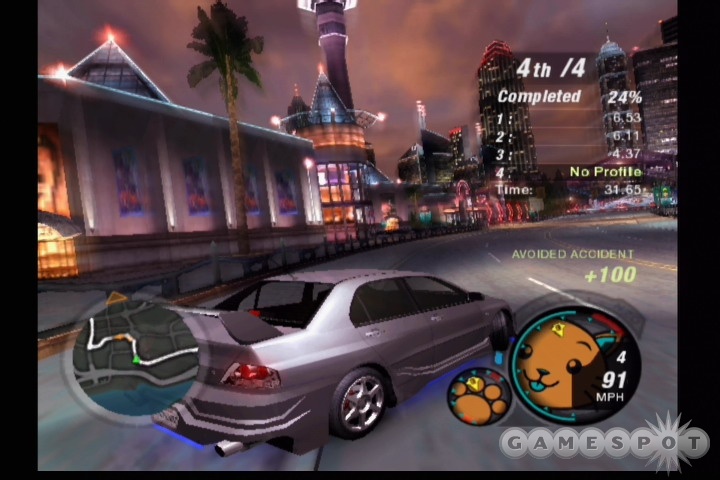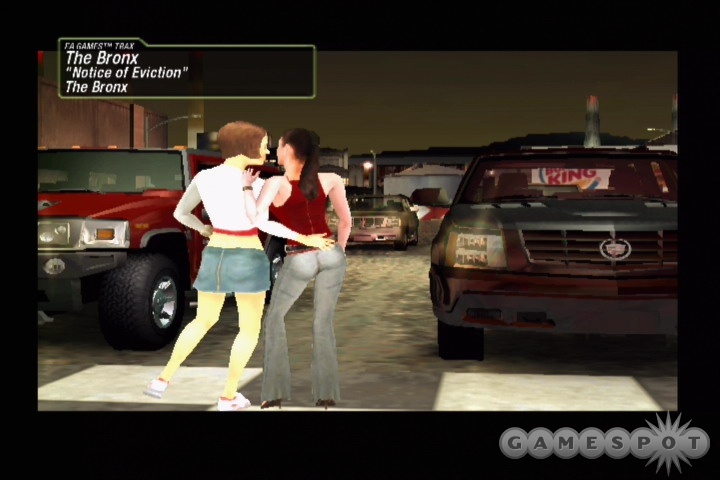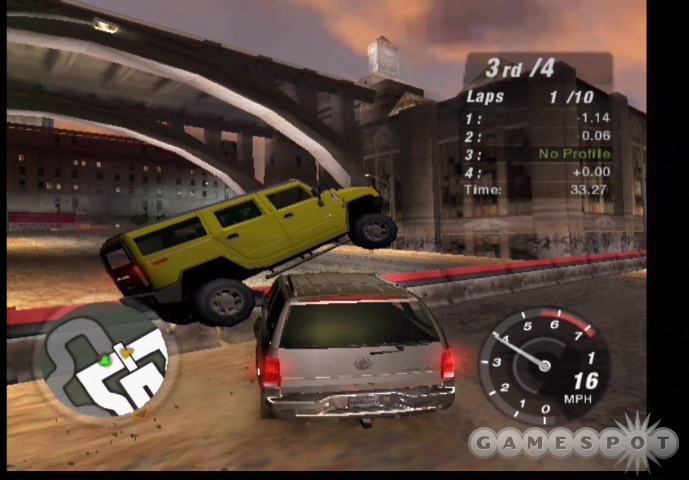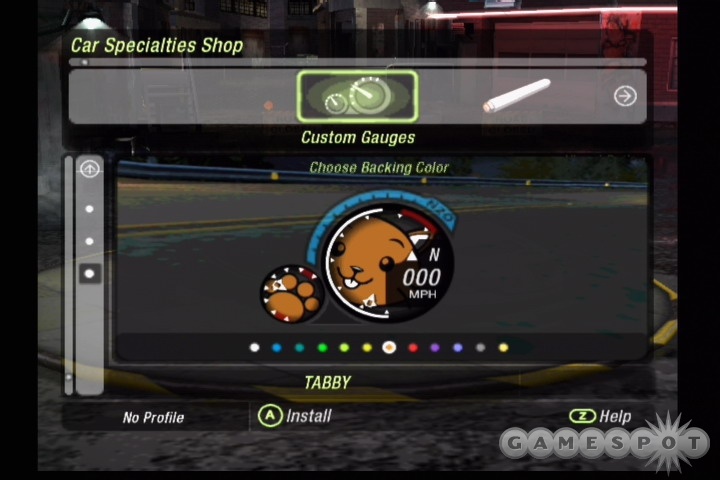Last year, EA took its long-running Need for Speed series in an exciting new direction with the release of Need for Speed Underground, a racing game that focused on making the import tuner scene the star of its arcade-style racing show. The game worked really well, combining the right level of car customization with good track design, challenging opponents, and impressive graphical effects. Now, one year later, a sequel is on the streets, adding some new race types and a big, open city to cruise around. The actual racing in Need for Speed Underground 2 is still pretty good, but unfortunately most of the stuff you do in between races keeps you away from the game's best moments.

Need for Speed Underground 2 tries to inject a story into your career mode using static-image cutscenes that pop up before some races. The effect is similar to what the Max Payne series does with its noninteractive sequences, though that game pulls it off much better than Need for Speed Underground 2 does. Dopey story short, you're sent off to a new town after getting ambushed by a rival racing crew, and you'll have to start from scratch with one car and a handful of races to get you going.
The biggest change made by this year's game is that the action now takes place in one large city. You're given free rein to drive around wherever you want, and you'll have to drive to races to drive in them. You'll also have to drive to different parts shops to customize your ride--in fact, you'll have to find most of the game's shops by cruising around the city, looking for the right type of colored lights. The game gives you an onscreen map, but shops don't show up until you've found them, and some races don't actually appear on the map, either.
On paper, this whole open-city thing sounds like an interesting idea. Someone probably sat down and said, "Well, everyone likes Grand Theft Auto, and it has an open city, so our game has to have an open city as well. In fact, let's even make it so that different sections of the city are locked away until you progress to a certain point in the career mode." In practice, driving around the city is a real drag that keeps you out of the action longer than you'd like. The game also rarely takes advantage of the open city for racing purposes, staging a majority of its events on preset tracks, rather than attempting to go for a Midnight Club-like "get there however you can" feel. There's a menu in the garage that lets you jump to a handful of different events, but most races don't show up here, and none of the shops do, either, making it completely useless.
You'll start out in some pretty slow cars, so the racing isn't very exciting until you earn enough for a full set of upgraded performance parts. But once you've done so, the racing is fun and the cars handle well. The cars are fast, and things like turning, powersliding, and proper corning technique are easy to pick-up. Like in last year's game, there are a handful of different race types: Circuit races are long lap-based events, sprints take you from point A to point B on a set course, drag racing lets you live your life a quarter mile at a time, and drift races rank you based on how squirrelly you can get on the track. New in this year's game are the street X races, which are essentially regular races that take place on drift tracks. Outrun races take place in various parts of the city--you roll up behind another racer, tap a button, and then try to pass and outrun him or her. You'll also encounter a few races against the clock, in which you'll have to get from one point in the city to another before a photographer leaves the area. Make it, and you'll get to put your car on the cover of one of the game's magazines or DVDs for extra cash. The big new race type is the "underground racing league." These races are the sort of mysterious events where you'll see most of the game's cutscenes. They mostly involve some knucklehead breaking the lock on a race track and then swinging open a gate so your street-racing posse can race on a "real" track, though you'll also bust into airports and such, too. These races are essentially circuit races with racetrack scenery instead of cityscape scenery.

Though there are three different difficulty settings for the career mode, none of them put up a particularly good fight. As a result, most of the races simply boil down to getting in front of the opposition and then doing what you can to not make a mistake. Between nitrous boosts and drafting, gaining the lead isn't very difficult, and the game doesn't seem to employ any heavy rubber-band AI routines to retake the lead from you, so you can usually stay in front without any trouble at all. When you consider that it will take you about a minute to get in front, and that some of the circuit races can last six minutes or more, this means that a great deal of your race time is spent just cruising along, dodging traffic and not paying any attention to the other cars unless you screw up and get into a wreck. In the event that you do crash, regaining the lead usually isn't too tough, especially if you've purchased a nitrous-oxide upgrade, which shamelessly lifts concepts from the Burnout series, translating powerslides and near-misses into extra boost for your tank. The opposing cars will slow down quite a bit if they take a big lead, making them very easy to beat.
Need for Speed Underground 2's crashes are laughably weak. While high-speed collisions with other cars trigger a slow-motion, cinematic shot of the crash, the game doesn't model any damage at all. It's like you're watching two plastic car models bump up against each other, accompanied by the sounds of an actual car crash. While it practically goes without saying that modeling damage in a game with licensed cars is still a tricky proposition, that fact doesn't make these wrecks look any better. Fortunately, the game's car customization features somewhat make up for this lack of visual detail.
A big part of Need for Speed Underground 2 is the ability to customize your car's performance and appearance. On the performance side, you'll purchase parts that have been organized into stages, which gives the game an easy way to lock the better parts away from you until you're ready for them. While the parts fall into different categories, like engines, brakes, tires, and ECUs, the only thing you really need to know is that you need them all to win races. The visual enhancements are a little more involved and give you a little more leeway, but ultimately you'll need to trick out the look of your cars to proceed, as having a flashy car is the only way to get noticed and end up on magazine and video covers. Each set of parts has a number associated with it, and these contribute to a meter that sums up how many pieces of flair you've bolted to your whip. Spoilers, neons, vinyls, roof scoops, spinner rims, custom gauges, and even speakers for your trunk are just some of the available modifications, and they all help your car stand out. This is especially handy online, where you can show off your stuff to the world.

Need for Speed Underground 2 is online on the PS2, PC, and new to this year's game, the Xbox. The online mode is pretty straightforward, letting you set up races in any of the game's race types, and it also features a free run mode, in case you just want to cruise around the city with other players. As you'd expect, the online mode works well over an average broadband connection, even with a full six players in a race. The game also does a good job with statistics and rankings, which can help you find evenly matched races. You can also limit races to cars of a certain rank, or just open it up and let people take their career-mode vehicles onto the track. The GameCube lacks online play, and to add insult to injury, the already-shaky frame rate gets a little shakier when you play in the GameCube version's splitscreen mode.
While Need for Speed Underground 2 is attempting to emulate an illegal scene of "underground" street racing, the game really tries to drive its product placement down your throat. Things like billboards on the sides of the roads aren't too bad (though with an ad for a financial service popping up on some signs, you have to wonder who EA's target audience for this game is), and the occasional real-life fast-food joint does its part to make the city feel a little more realistic. But basing the game's whole onscreen display around the logo for a cellular phone service provider crosses the line. Sorry, but there's nothing "underground" about forcing a bunch of non-car-related corporate logos on people. The game's hokey dialogue also adds to the counterfeit feel. The overzealous script is constantly throwing poorly placed slang at you, having Brooke Burke use her teleprompter voice to tell you that "you've got to be racing tight," constantly calling you "dawg," or being very careful to always call your money "bank."
Graphically, Need for Speed Underground 2 looks good, unless you're talking about the GameCube version, which has a wildly unstable frame rate that really gets in the way of the action in some races. But in the other three versions, the car models are sharp and the city looks fine. For the most part, the game keeps running at a smooth frame rate, even in the later stages, when you're moving much, much faster. But at the same time, it isn't quite the effects show that the last game was. You still get nice little effects, like the shaky camera used to show drag races, but the blur effects are much less pronounced now, which is too bad, because they were really well implemented last year. Now, you get blurring at very high speeds or when you kick in the nitrous oxide, but more would have been better. Like last year, the PS2 version is the heaviest on the effects, though the overall look is still a little subdued. For the most part, the different versions of the game look very similar, with the Xbox and PC versions allowing for slightly higher visual fidelity than the PlayStation 2 version, and the GameCube version bringing up the rear, but ultimately the only major differences come down to the GameCube version not having online support, the Xbox version's analog triggers being the best control scheme for the game, and the PC version not playing very well with the keyboard controls (you'll need at least an analog gamepad if you're planning on playing this game on the PC).
The game's sound rises above its lame dialogue and poorly delivered speech. The engine sounds aren't quite as deep or as throaty as you might like, but the game is great at changing the sound of your car as you purchase upgrades. Also, things like the whoosh of wind when you fly under an overpass really help sell the game's sense of speed.

Musically, Need for Speed Underground 2 is all over the place. The schizophrenic sounds start with the game's lead song, which is a remix of The Doors' "Riders on the Storm" done by prominent rap producer Fredwreck. Snoop Dogg joins Jim Morrison on the vocals here. For some people that will be blasphemy, but the remix sounds pretty good. The part that ruins it, though, is that Snoop is rapping about the racing--Need for Speed is specifically mentioned in the lyrics. Again, if you're going to have a game with "underground" right in the name, showcasing a song that does double duty as both an ad for the game and as an extreme case of exploitation of an old favorite probably isn't the best idea. Other songs on the soundtrack include "Lean Back" by the Terror Squad, "LAX" by Xzibit, and tracks from Sly Boogy, Felix Da Housecat, Paul Van Dyk, Cirrus, Ministry, Queens of the Stone Age, Mudvayne, Helmet, and more. This is a textbook case of a soundtrack that tries to appeal to too many different audiences and ends up not including enough of any one style to please anyone. Xbox users won't be able to fix the problem, either, as the game doesn't contain custom-soundtrack support. However, you'll be able to at least turn off tracks that you don't like.
Need for Speed Underground 2 starts with last year's game as a template and builds from there. Unfortunately, almost everything that has been added to this year's game detracts from the overall experience. Once you're in and racing and customizing your cars, it's a lot of fun, but there are too many obstacles standing between you and the best parts of the game.



